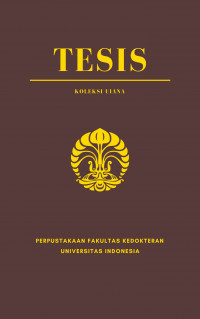Tesis
Kualitas Hidup Pasien Kanker Serviks pasca Radiasi menggunakan Kuesioner EORTC QLQ - C30 dan CX24 = Quality of Life of Cervical Cancer Patients After Radiation based on the EORTC QLQ C-30 and CX-24 Questionnaire.
Tujuan: Mengetahui karakteristis kualitas hidup serta faktor risiko yang berpengaruh pada pasien kanker serviks stadium lanjut lokal pasca radiasi Metode: Penelitian adalah penelitian potong lintang pada 82 subjek penelitian. Uji normalitas menggunakan uji KolmogorovSmirnov dan perbandingan rerata menggunakan uji Mann Whitney Hasil: Rerata kualitas hidup skala kesehatan global 74,49%, skala fungsional 87,39%, skala gejala umum 39,02%, skala fungsional seksual 45,94%, dan skala gejala seksual 42,68%. Kesimpulan: Kualitas hidup pasien kanker servis pasca radiasi tergolong baik, kecuali pada skala fungsi seksual. Faktor terkait penyakit yang secara statistik signifikan dalam mempengaruhi peningkatan kualitas hidup adalah stadium lebih dini dan tidak ada komorbid; diferensiasi baik mempengaruhi peningkatan kualitas hidup walau tidak signifikan. Faktor terkait pengobatan yang secara statistik signifikan dalam mempengaruhi peningkatan kualitas hidup adalah interval waktu diagnosis dan tatalaksana ≤ 90 hari, overall treatment time ≤ 56 hari, teknik brakiterapi, dan pemberian kemoradiasi; sedangkan respon terapi komplit dan tidak ada efek samping mempengaruhi peningkatan kualitas hidup walau tidak signifikan. Faktor terkait sosioekonomi yang secara statistik mempengaruhi peningkatan kualitas hidup adalah usia ≤ 45 tahun, status menikah, pendidikan lanjutan, dan penghasilan diatas UMR.
Kata Kunci: kualitas hidup, kanker serviks, radiasi, radioterapi
Aims: Knowing the characteristics of quality of life and risk factors that affect advanced local cervical cancer patients after radiation Materials and methods: The study was a crosssectional study on 82 research subjects. Normality test using the Kolmogorov-Smirnov test and comparison of the mean using the Mann Whitney test. Results: The mean of quality of life on the global health scale is 74.49%, the functional scale is 87.39%, the general symptom scale is 39.02%, the sexual functional scale is 45.94%, and the sexual symptom scale is 42.68%. Conclusion: The quality of life of post-radiation cervical cancer patients is good, except on the sexual function scale. Disease-related factors that were statistically significant in influencing the improvement of the quality of life were earlier stage and no comorbidities; Good differentiation affects the quality of life, although not significantly. Treatment-related factors that were statistically significant in influencing the improvement of the quality of life were the interval between diagnosis and treatment ≤ 90 days, overall treatment time ≤ 56 days, brachytherapy technique, and chemoradiation; while the complete therapy response and no side effects affected the improvement of the quality of life, although not significantly. Socio-economic related factors that statistically affect the improvement of the quality of life are age ≤ 45 years, marital status, further education, and income above the minimum wage.
Key words: quality of life, cervical cancer, radiation, radiotherapy
- Judul Seri
-
-
- Tahun Terbit
-
2021
- Pengarang
-
Widyanti Imran - Nama Orang
Sri Mutya Sekarutami - Nama Orang
Fitriyadi Kusuma - Nama Orang
Hartono Tjahjadi - Nama Orang
Endang Nuryadi - Nama Orang
Henry Kodrat - Nama Orang - No. Panggil
-
T21241fk
- Penerbit
- Jakarta : Program Pendidikan Dokter Spesialis Onkologi Radiasi., 2021
- Deskripsi Fisik
-
xv, 86 hal; ill; 21 x 30 cm
- Bahasa
-
Indonesia
- ISBN/ISSN
-
-
- Klasifikasi
-
NONE
- Edisi
-
-
- Subjek
- Info Detail Spesifik
-
Tanpa Hardcopy
| T21241fk | T21241fk | Perpustakaan FKUI | Tersedia |


Masuk ke area anggota untuk memberikan review tentang koleksi